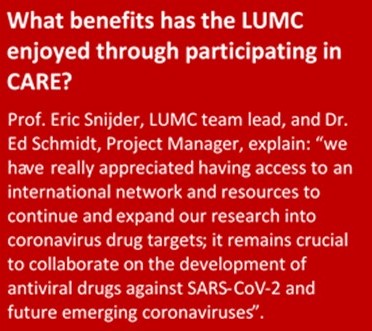November 9th 2023
Introducing Leiden University Medical Center – a CARE academic organisation
Introducing Leiden University Medical Center – a CARE academic organisation

The LUMC has a long history and has its origins in the 16th century when in 1575, following a year-long siege, William of Orange granted Leiden the right to have a university. The university started with 3 faculties: Law, Theology and Medicine.
In 1996, the Leiden University Medical Center (LUMC) emerged from the collaboration between the Leiden University Hospital and the Faculty of Medicine of Leiden University.
Today, it is a centre of medical innovation that aims to improve patient care through scientific research. It trains doctors and biomedical researchers to contribute to this. In addition to general patient care, the LUMC offers specialist treatments that may only be performed in a limited number of medical centres. The LUMC distinguishes itself in particular as a referral center for complex medical questions for which there are no ready-made answers. As of 2024, all fundamental, translational and clinical research related to pathogens and infectious diseases will be integrated in the new Leiden University Center of Infectious Diseases (LUCID). This month, LUMC is opening a new Biosafety Level 3 (BSL-3) research facility, including two units to be used for studies on SARS-CoV-2 and other pathogenic coronaviruses.

The LUMC has 3 social spearheads: oncology, regenerative medicine and population health. These spearheads relate to important issues in society and medicine. Approximately 7000 people work at LUMC today.
Why did the LUMC choose to get involved in CARE?
The LUMC molecular virology team has a >30-year track record in studying the biology of coronaviruses, including a number of previous projects in antiviral drug research. LUMC decided to get involved with CARE because of the need to establish an international response to the rapidly developing SARS-CoV-2 pandemic, thus facilitating scientific collaboration and the sharing of expertise and toolboxes. Moreover, since February 2020, LUMC was coordinating the EU-funded SCORE project to target SARS-CoV-2, and its eight partners thus became a sub-network within CARE. This enabled the rapid exchange of knowledge, technologies, reagents, and candidate antiviral drugs between the two projects.
What has the LUMC delivered for CARE?
The LUMC’s achievements in CARE include many aspects in Work Packages (WP) 1, 2, 5, 6, 7 and 8 (For more information information about the different work packages, please click here.). LUMC developed assays and reagents in WP1 and 2 to better define coronavirus drug targets, and characterize and select antiviral compounds developed by other partners. Such studies into the mechanism-of-action of CARE’s drug candidates continue to constitute the bulk of LUMC’s contribution. Furthermore, LUMC performed “omics” studies in WP5, established animal models and performed preclinical studies on candidate antivirals in WP6; performed dual-transcriptomics studies in WP7; and organized a European Medicines Agency (EMA) meeting to obtain advice on combinational treatments for immune-compromised patients in WP8.


The LUMC CARE team currently includes:
Montse Bárcena, Nina de Beijer, Jonna Bloeme, Brenda Bontes, Jutte de Vries, Mirjam Groenewold, Sytze Jorritsma, Marjolein Kikkert, Marissa Linger, Kees Mourik, Sebe Myeni, Ana Roque, Anna Roukens, Ed Schmidt, Eric Snijder, Thijs Steijaert, Ali Tas, Emmely Treffers, Martijn van Hemert, Peter van Veelen, Patrick Wanningen, and Jessika Zevenhoven.
